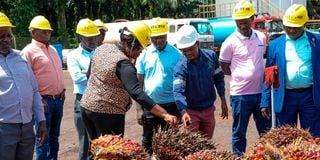Premium
Oil palm: Next agriculture frontier for Homa Bay County

Governor Gladys Wanga and county government officials on Ssese island, Uganda, in May 2023.
What you need to know:
- Governor Gladys Wanga and her deputy Oyugi Magwanga recently led a team to Uganda on an oil palm growing benchmarking.
- Devolved government also wants local farmers to increase the production of indigenous crops, including sunflower, groundnut and cotton.
Homa Bay County has positioned itself to be the chief producer of enabled oil crops in Kenya.
The devolved government has begun identifying farmers to grow oil palm. The plant will be grown in selected areas on the shores of Lake Victoria.
Governor Gladys Wanga and her deputy Oyugi Magwanga recently led a team to Uganda on an oil palm growing benchmarking.
They were accompanied by the management of Bidco Africa.
The team toured Ssese island. It was hosted by Oil Palm Uganda Limited, which has over the years invested in growing nearly a million oil palm trees.
Governor Wanga said the visit gave her team a chance to learn about production of the crop. She said Ssese weather and soil types are similar to Homa Bay’s.
“I see no difficulties duplicating what is happening in Uganda. We are looking forward to growing oil palm,” the governor said.
Since the visit, officials in the Agriculture Department of the devolved government have been holding meetings with farmers to sensitise them on the benefits of the crop.
The tree takes about four years to mature. According to the department, an oil palm farmer can earn Sh150,000 to Sh200,000 per acre in one harvest.

Homa Bay Governor Gladys Wanga’s delegation comprising county government officials and private sector stakeholders, in Ssese Island, Uganda.
Harvesting can go on for 20 years. One can still plant other crops on the same piece of land.
The Homa Bay devolved government hopes to partner with Bidco Africa and the Kenya Agriculture and Livestock Research Organisation (Kalro) in the oil palm venture.
Kalro will help source the best seeds. Mfangano Island is among the areas identified as suitable for oil palm production.
The county government wants a seed production farm established in Kanam, Rachuonnyo North, a sub-county that plays host to a farmers training and research centre that is largely underutilised.
Besides oil palm, the devolved government wants farmers to increase production of indigineous crops, including sunflower, groundnut and cotton.
Most of the food produced in Homa Bay is supplied to other counties. The Department of Agriculture says up to 75 per cent of Homa Bay households depend on farming for income.
The mapping of agricultural value chain actors is crucial, entailing the registration of farmers and their enterprises. At least 500,000 farmers will be registered, the county government says.
About 150,000 were registered by the national government in March.
“Whoever does not register will not get subsidised inputs. A voucher issued after registration is what will be used to get the inputs,” the governor said.

Homa Bay Governor Gladys Wanga with county government officials on a tour at an oil palm factory in Ssese Island, Uganda in May 2023.
Some 575 enumerators and supervisors have been hired for the registration.
The exercise began after the devolved government and the Kenya Crops and Dairy Market System conducted soil testing so as to identify suitable fertiliser for different locations.
Magwanga, who also serves as the Agriculture executive, said the enumerators and supervisors have a background in crop and animal farming.
“Homa Bay can produce many crops. The biggest challenge farmers face is lack of support. We are doing all we can to reverse this,” the deputy county boss said.
He added that Homa Bay must not rely on relief during drought and should not import food to feed its 1.2 million residents.
Magwanga advised locals to commercialise their farming, adding that oil palm growing would improve their economic standing.
“We need to be at the same level or even better than counties like Kericho and Nandi. We have the ideal environment and soil for producing many crops,” he said.
At the same time, the Homa Bay devolved government says it plans to employ field extension officers.
That, Magwanga said, would help farmers get knowledge on activities that ensure maximum production.





